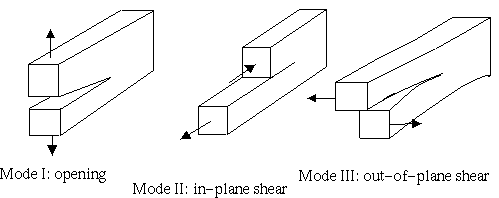|
The ways to calculate a crack, how it begins, how it grows, and if it stops,
are all part of the field called fracture mechanics. There are
many, many ways to try to calculate a crack. In fact, people are still
fighting about which way is the right way. The right way really depends on
what kind of material and what type of structure you're talking about. Here
we'll discuss a version of fracture mechanics which can be applied to large
concrete structures, like dams.
First some general ideas in fracture mechanics.
Forces
There has to be some sort of force acting on a material to make it
fracture. There are three major forces to consider:
- temperature variation -- this can be a
big problem in concrete. As you learned earlier in the section on concrete, when concrete is mixed it gets very hot
and expands. When it tries to cool off, the concrete wants to contract. If
it can't contract (because it is connected to another wall or rock) then
cracks form.
- chemical reaction -- a reaction between the
cement and the aggregate in the concrete which makes the concrete "grow"
- live load -- the general pulling or pushing on a material. In a dam,
loads could be caused by settling or sliding of the foundation or abutments,
ice, silt, waves,
earthquakes, or even bombs or asteroids!
Find out more on the forces on arch,
buttress, gravity,
and embankment dams.
Modes
These forces are simplified into three different "modes", basically three
ways the forces can act and what kind of fracture they cause:

- Mode I: the forces are perpendicular to the crack (the crack
is horizontal and the forces are vertical), pulling the crack open. This is
referred to as the opening mode.
What would happen if both of the forces were pushing down on the crack?
Nothing. This would close the crack.
- Mode II: the forces are
parallel to the crack. One force is pushing the top half of the crack back
and the other is pulling the bottom half of the crack forward, both along the
same line. This creates a shear crack: the crack is sliding along itself. It
is called in-plane shear beacuse the forces are not causing the material to
move out of its original plane.
In this case, what would happen if both the forces were moving in the same
direction, both forward or both backward? This would not cause the crack to
grow, since all of the material would be moving in the same direction.
- Mode III: the forces are perpendicular to the crack (the crack is
in front-back direction, the forces are pulling left and right). This causes
the material to separate and slide along itself, moving out of its original
plane (which is why its called out-of-plane shear). The forces could also be
pushing left and right and the same effect would occur. But the forces
have to be moving in opposite directions in order to grow the crack.
You can try to create each of these modes yourself!
More than one of these modes can happen at once, which causes "mixed-mode"
cracking. But we'll just concentrate on one mode, Mode I, to learn some of
the basics of fracture mechanics.
Mode I cracking happens in concrete dams. If there is an existing crack on
the upstream side, water can enter and open the crack:
KI and KIc
How do we describe what's happening during Mode I cracking? To help us do
this, there is something called a stress intensity factor, which has
the symbol KI.
KI is basically a measure of the likelihood that the crack
will grow when the opening forces are being applied. Think of KI as
as the crack's money: if the crack has enough money, then it can
do what it wants, which is grow. How much money the crack has, KI
is based on the load on the structure and the initial size of the crack.
Now KIc is a material's resistance to crack growth.
KIc tells you when the material will allow a crack to grow.
This is a property which can be measured in a
laboratory. We'll leave it at that for now.
|




